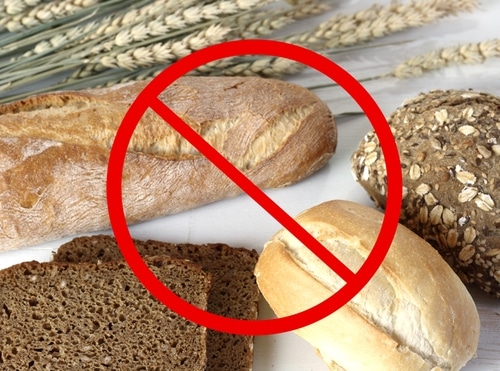 More people are going gluten-free these days. If you have celiac disease this is an absolute must since your intestines become inflamed when you expose them to even small amounts of gluten. There are a significant number of other people without celiac disease who believe they’re sensitive to gluten. They haven’t been diagnosed with celiac disease but experience bloating, indigestion, diarrhea or a host of other symptoms when they eat foods containing gluten. Some experience relief when they eliminate gluten-containing foods.
More people are going gluten-free these days. If you have celiac disease this is an absolute must since your intestines become inflamed when you expose them to even small amounts of gluten. There are a significant number of other people without celiac disease who believe they’re sensitive to gluten. They haven’t been diagnosed with celiac disease but experience bloating, indigestion, diarrhea or a host of other symptoms when they eat foods containing gluten. Some experience relief when they eliminate gluten-containing foods.
If you feel better eating a gluten-free diet, there’s no reason not to do it – but it’s important to avoid the pitfalls of this type of diet. Gluten-free isn’t necessarily synonymous with “healthy.” It’s all too easy to reach for the growing number of gluten-free products you find on store shelves these days and toss them in your grocery cart. They may be quick and convenient to prepare but not necessarily healthy. If you eliminate gluten from your diet, do it the right way, making sure you’re not compromising on nutrition.
The Challenges of Going Gluten-Free Diet
Eating a gluten-free diet isn’t always easy. In fact, it can be quite challenging. You already know you can’t eat wheat, rye, barley, and some oats. (unless you know they were packaged in a gluten-free facility) Doesn’t sound so hard, does it?
The problem is you can also find gluten “hiding” in a number of packaged foods including crunchy snacks like chips, candy, processed meats, condiments, soup mixes and any number of other processed and prepared foods. Even some medications and personal care products contain small amounts of gluten! The reason? Wheat derivatives are sometimes used as thickeners and stabilizers in these products.
Because of this problem and the growing number of people who want to avoid gluten, companies are putting out more gluten-free packaged products. Sounds like a good idea – but are you doing your health a favor when you add them to your refrigerator, cabinet and, ultimately, your tummy?
The problem is many gluten-free products are still high in sugar and salt and contain preservatives and other additives. Plus, they’re often low in fiber. In addition, they lack the natural phytochemicals that help to keep your cells healthy. They may be a solution to your digestive issues but not so good for your overall health.
A Better Way to Eliminate Gluten
Fortunately, you CAN eat healthy on a gluten-free diet if you stop searching for gluten-free labels and stick with foods that are naturally free of gluten. When you take this approach, you can choose from a wide array of fruits and vegetables and team them up with organic, lean sources of protein like turkey, chicken and grass-fed beef. Avoid packaged and ready-to-prepare meats since they may contain bread crumbs or other fillers.
You can also enjoy nuts, seeds, dairy and eggs, all foods that are good for you in moderation. Dairy-free milk may or may not be gluten-free. Always check. Seasoned nuts can contain gluten too. Look for raw nuts and store them in the refrigerator to keep them from going rancid.
What about grain alternatives? Although not a true grain, some people on a gluten-free diet serve quinoa as an alternative to whole grains but a recent study published in the American Journal of Clinical Nutrition raises questions about the safety of doing this if you have celiac disease. This research showed that even though quinoa is gluten-free, it may contain other proteins that activate the immune system of people with celiac disease. So this may be one to avoid if you have celiac disease.
If you bake and need flour – it’s best to stick with flax meal, coconut flour or nut flours. Almond flour and coconut flour are both good choices. They’re not only free of gluten, but they’re high in fiber and lower in carbs than most other flours.
Eating Out in Restaurants
It’s challenging enough finding healthy things to eat at restaurants but eating gluten-free makes it even harder. Fortunately, some chain restaurants now offer gluten-free items, although they aren’t necessarily healthy. The best way to find out what they offer is to visit their website beforehand and look for nutritional information. They’ll usually let you know on that page of any gluten-free items they offer. If you don’t see mention of gluten-free, email the company headquarters to get more information.
The Take-Home Message?
Just because you’re eating gluten-free doesn’t mean you’re eating healthy. Some people think when they see gluten-free on a label that it must be better for them. Gluten-free packaged foods may be free of gluten but they can still be high in sodium, sugar, fat and contain other additives and preservatives.
Stick with the periphery of the grocery store where the fresh produce is and shop at a natural food market where you can get lean, organic meat and wild-caught fish to enhance your diet. Don’t get caught up in looking for gluten-free products, choose foods that are naturally free of it.
References:
American Journal of Clinical Nutrition. 2012 Aug;96(2):337-44.
Related Articles By Cathe:
Things to Consider Before Going Gluten-Free

